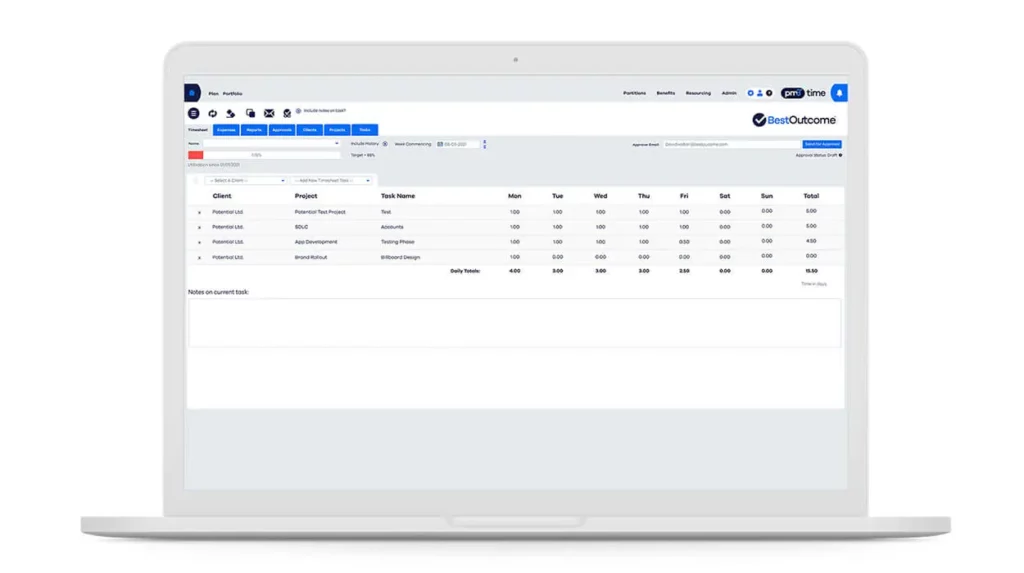
In today’s fast-paced business landscape, every minute counts. Understanding how time is spent within your organisation is crucial for maintaining efficiency, optimising resources and driving productivity. This is where timesheets come into play. They’re not just mundane administrative tasks; they’re the backbone of clear operations, enhanced project management and streamlined workflows.
In this article, we consider five essential reasons why timesheets are indispensable for your organisation’s success. From accurate time tracking to improved invoicing, enhanced project management, streamlined workflow processes and increased productivity and profitability, we explore how implementing a robust timesheet system like BestOutcome’s PM3Time can revolutionise your business operations.
Timesheets aren’t just about logging hours; they’re essential for understanding how time is spent in your organisation.
Real-time tracking means no billable minutes are missed, even in remote or flexible work environments. Online timesheets let employees specify the projects and tasks they’re working on, providing management with a detailed view of how work hours are spent.
Employee timesheets promote accountability and transparency in large and small businesses alike. While employees tend to understand that tracking time is about optimising productivity, not micromanagement, automated reminders prompt employees to submit their timesheets by the designated end time, ensuring that errors and delays are kept to a minimum.
With BestOutcome’s time tracking software PM3Time, tracking employee hours is straightforward and transparent, giving you a clear picture of where resources are allocated and how effectively employees are working.
PM3Time’s user-friendly time entry interface makes it easy for employees to record their hours, whether they’re at their desks or on the move. The mobile app (Android and iOS) serves as a reliable time tracking app, ensuring that time tracking isn’t limited to the office and allowing employees to log hours from anywhere using their mobile phone or any other mobile device.
Once facilitated through PM3Time’s intuitive timesheet app, timesheets are more than just administrative tools; they’re the foundation of efficient operations.
Accurate time tracking isn’t just about knowing how time is spent; it’s also about ensuring that your organisation gets compensated fairly for the work done. Timesheets play a pivotal role in streamlining the invoicing and client billing process, ensuring that every billable hour is accounted for and accurately billed.
With PM3Time‘s seamless integration with accounting software like Xero, invoicing becomes a breeze. By automatically generating invoices using the data captured in PM3Time, you can eliminate the tedious task of manually inputting hours into invoices. This integration ensures that invoices are accurate and reflect the actual time spent on each project, minimising disputes and delays in payment.
Moreover, PM3Time’s project costing functionality allows you to maintain multiple rates per person and by role, ensuring that you capture the true cost of each project. Job costing reports generated through PM3Time provide valuable insights into project profitability and resource allocation, allowing you to make informed decisions about pricing and resource allocation.
By leveraging PM3Time’s reporting features, you can easily track billable hours, monitor project budgets and analyse profitability. Whether you need to generate detailed reports for internal analysis or provide clients with transparent billing breakdowns, PM3Time offers a wide range of reporting options to suit your needs.
Furthermore, PM3Time’s ability to generate invoices directly from timesheet data eliminates the need for manual data entry, saving time and reducing the risk of errors. This integration between time tracking and invoicing ensures that invoices are accurate, timely and reflective of the value delivered to clients.
In conclusion, timesheets are not just a tool for tracking hours; they’re a critical component of the invoicing and billing process. By using PM3Time’s robust functionality for project costing, reporting and integration with accounting software, organisations can streamline their invoicing processes, improve cash flow and enhance client satisfaction. With PM3Time, you can ensure that your organisation gets compensated fairly for the work done, ultimately driving profitability and success.
Effective project management hinges on having a clear understanding of how resources, including time, are allocated and utilised. Timesheets serve as invaluable tools in this regard, providing project managers with real-time insights into resource allocation, task progress, and project timelines.
With PM3Time‘s intuitive interface, project managers can easily track employee time against specific projects and tasks. This real-time visibility allows them to identify potential bottlenecks, allocate resources more effectively and make informed decisions to keep projects on track.
By tracking employee time with precision, project managers can ensure that resources are not stretched and that project timelines are adhered to. PM3Time’s reporting features enable project managers to generate customisable reports, providing them with actionable insights into project performance and resource utilisation.
Moreover, PM3Time’s integration with project management software enhances collaboration and coordination among team members. By synchronising project workflows with time tracking data, organisations can streamline the project workflows and improve overall efficiency.
In addition to optimising resource allocation, timesheets facilitate accurate project costing and budgeting. By tracking employee time against specific projects and tasks, project managers can monitor project costs in real-time and identify any potential cost overruns early on. PM3Time’s project costing functionality allows for the maintenance of multiple rates per person and by role, ensuring that project costs are accurately captured and accounted for.

In the realm of business operations, efficiency is paramount. Timesheets play a pivotal role in streamlining workflow and simplifying the approval process, ensuring that time tracking remains consistent, accurate and hassle-free.
Traditionally, paper-based timesheets were prone to errors, delays and the cumbersome process of manual approval. However, with automated timesheet software like PM3Time, organisations can significantly reduce administrative burden and streamline the approval process.
PM3Time’s self-service functionality empowers employees to submit their timesheets online effortlessly. Whether they’re in the office or working remotely, employees can log their hours with ease using the mobile app or web interface. This accessibility ensures that time tracking remains consistent and up to date, even in dynamic work environments.
One of the standout features of PM3Time is its seamless approval process. Unlike traditional timesheet systems that require managers to log in to a separate platform for approvals, PM3Time allows managers to approve timesheets directly from their email inbox. This self-service functionality saves time for both employees and managers, accelerating the approval process and ensuring timely submission of timesheets.
Furthermore, PM3Time’s automated reminders and notifications keep the approval process on track. Employees receive prompts to submit their timesheets, while managers are notified when timesheets are ready for approval. This proactive approach reduces the likelihood of delays and ensures that timesheets are processed efficiently.
Additionally, PM3Time offers customisable approval workflows, allowing organisations to define roles and permissions based on their unique requirements. Whether it’s multi-tiered approvals or specific criteria for approval, PM3Time can adapt to your organisation’s workflow seamlessly.
By streamlining the approval process, PM3Time enhances collaboration, communication and transparency within the organisation. Employees feel empowered to manage their time effectively, while managers have the visibility they need to monitor resource allocation and project progress.
At the heart of every successful organisation lies the quest for productivity and profitability. Timesheets serve as catalysts for achieving these goals by providing insights into employee performance, resource utilisation and project profitability.
By accurately tracking employee time with PM3Time, organisations gain a deeper understanding of how time is spent across different projects and tasks. This visibility enables management to identify inefficiencies, optimise workflows and allocate resources more effectively, ultimately leading to increased productivity.
PM3Time’s customisable features allow organisations to configure timesheet formats and set utilisation targets by role and person. By establishing clear expectations and goals for time management, organisations can motivate employees to work more efficiently and productively.
Moreover, PM3Time’s integration with project management software enhances collaboration and coordination among team members, further boosting productivity. By synchronising time tracking data with project workflows, organisations can streamline processes, minimise delays and ensure that projects are completed on time and within budget.
Accurate time tracking also has a direct impact on profitability. By understanding how employee time is allocated and associated costs are incurred, organisations can make data-driven decisions to maximise profitability. PM3Time’s project costing functionality allows organisations to maintain multiple rates per person and by role, ensuring that project costs are properly captured and accounted for.
Additionally, PM3Time’s integration with accounting software like Xero simplifies the invoicing process, ensuring that clients are billed accurately and promptly. By automating the generation of invoices using timesheet data, organisations can eliminate manual errors and delays, improving cash flow and profitability.
Furthermore, PM3Time’s reporting features enable organisations to analyse employee performance, project profitability and resource utilisation trends. By identifying areas for improvement and implementing targeted interventions, organisations can continuously optimise productivity and profitability over time.
In essence, timesheets are not just administrative tools; they’re strategic assets for driving productivity and profitability. By leveraging PM3Time’s intuitive interface, customisable features and seamless integrations, organisations can unlock the full potential of their workforce, optimise resource allocation and achieve sustainable growth and success.

Our products help you deliver successful change programmes and projects by always focusing on the overall business outcomes. Find out how our products can help you.
Tell me More Watch a DemoTimesheets are not a glamorous subject to talk about, but they do play an important role in many org...
Read more >Timesheets are not a glamorous subject to talk about, but they do play an important role in many org...
Read more >The first entries are adverts which are predominately from US based companies....
Read more >